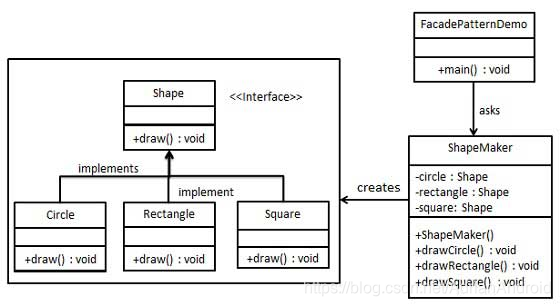移動開發之設計模式- 外觀模式(IOS&Android)
阿新 • • 發佈:2018-12-19
資源
完全參照 外觀模式|菜鳥教程 ,但不包括IOS程式碼
外觀模式
外觀模式(Facade Pattern)隱藏系統的複雜性,並向客戶端提供了一個客戶端可以訪問系統的介面。這種型別的設計模式屬於結構型模式,它向現有的系統新增一個介面,來隱藏系統的複雜性。
這種模式涉及到一個單一的類,該類提供了客戶端請求的簡化方法和對現有系統類方法的委託呼叫。
介紹
意圖: 為子系統中的一組介面提供一個一致的介面,外觀模式定義了一個高層介面,這個介面使得這一子系統更加容易使用。
主要解決: 降低訪問複雜系統的內部子系統時的複雜度,簡化客戶端與之的介面。
何時使用:
1、客戶端不需要知道系統內部的複雜聯絡,整個系統只需提供一個"接待員"即可。
2、定義系統的入口。
如何解決: 客戶端不與系統耦合,外觀類與系統耦合。
關鍵程式碼:在客戶端和複雜系統之間再加一層,這一層將呼叫順序、依賴關係等處理好。
應用例項:
1、去醫院看病,可能要去掛號、門診、劃價、取藥,讓患者或患者家屬覺得很複雜,如果有提供接待人員,只讓接待人員來處理,就很方便。
2、JAVA 的三層開發模式。
優點:
1、減少系統相互依賴。
2、提高靈活性。
3、提高了安全性。
缺點: 不符合開閉原則,如果要改東西很麻煩,繼承重寫都不合適。
使用場景:
1、為複雜的模組或子系統提供外界訪問的模組。
2、子系統相對獨立。
3、預防低水平人員帶來的風險。
注意事項:在層次化結構中,可以使用外觀模式定義系統中每一層的入口。

#Android
Shape.java
public interface Shape {
void draw();
}
Rectangle.java
public class Rectangle implements Shape {
@Override
public void draw() {
System.out.println("Rectangle::draw()");
}
}
Square.java
public class Square implements Shape { @Override public void draw() { System.out.println("Square::draw()"); } }
Circle.java
public class Circle implements Shape {
@Override
public void draw() {
System.out.println("Circle::draw()");
}
}
ShapeMaker.java
public class ShapeMaker {
private Shape circle;
private Shape rectangle;
private Shape square;
public ShapeMaker() {
circle = new Circle();
rectangle = new Rectangle();
square = new Square();
}
public void drawCircle(){
circle.draw();
}
public void drawRectangle(){
rectangle.draw();
}
public void drawSquare(){
square.draw();
}
}
FacadePatternDemo.java
public class FacadePatternDemo {
public static void main(String[] args) {
ShapeMaker shapeMaker = new ShapeMaker();
shapeMaker.drawCircle();
shapeMaker.drawRectangle();
shapeMaker.drawSquare();
}
}
結果
Circle::draw()
Rectangle::draw()
Square::draw()
IOS
Shape.h
#import <Foundation/Foundation.h>
@protocol Shape <NSObject>
-(void)draw;
@end
@interface Rectangle:NSObject<Shape>
@end
@interface Square:NSObject<Shape>
@end
@interface Circle:NSObject<Shape>
@end
Shape.m
#import "Shape.h"
@implementation Rectangle
- (void)draw {
NSLog(@"Rectangle::draw()");
}
@end
@implementation Square
- (void)draw {
NSLog(@"Square::draw()");
}
@end
@implementation Circle
- (void)draw {
NSLog(@"Circle::draw()");
}
@end
ShapeMaker.h
#import <Foundation/Foundation.h>
@interface ShapeMaker : NSObject
-(void)drawCircle;
-(void)drawRectangle;
-(void)drawSquare;
@end
ShapeMaker.m
#import "ShapeMaker.h"
#import "Shape.h"
@interface ShapeMaker()
@property (nonatomic, strong) id<Shape> circle;
@property (nonatomic, strong) id<Shape> rectangle;
@property (nonatomic, strong) id<Shape> square;
@end
@implementation ShapeMaker
- (instancetype)init
{
self = [super init];
if (self) {
self.circle = Circle.new;
self.rectangle = Rectangle.new;
self.square = Square.new;
}
return self;
}
- (void)drawCircle{
[self.circle draw];
}
- (void)drawRectangle{
[self.rectangle draw];
}
- (void)drawSquare{
[self.square draw];
}
@end
ViewController
- (void)viewDidLoad {
[super viewDidLoad];
// Do any additional setup after loading the view, typically from a nib.
ShapeMaker *shapeMaker = ShapeMaker.new;
[shapeMaker drawCircle];
[shapeMaker drawRectangle];
[shapeMaker drawSquare];
}
結果
Circle::draw()
Rectangle::draw()
Square::draw()
